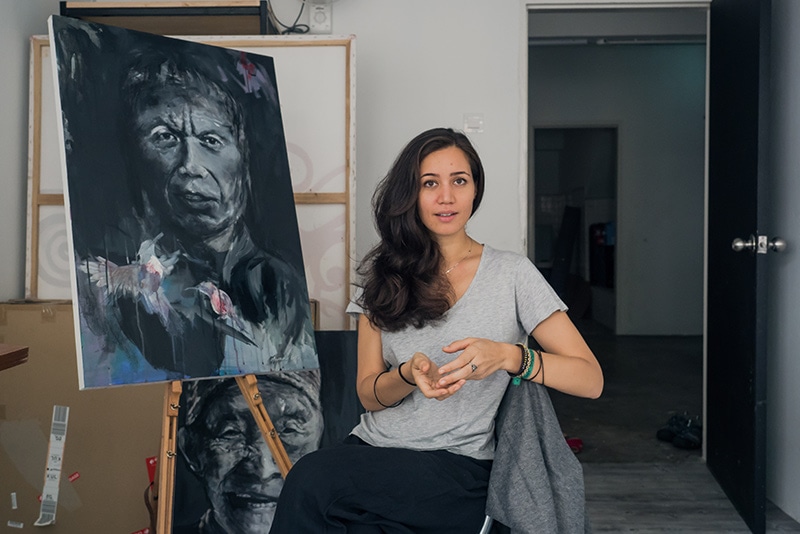Everyday Essentials with Alena Murang
As an ethnic musician and artist, Alena Murang uses her part Kelabit heritage to champion the Borneo environment through music and other forms of art. She also started “ART4 Studio”, an organisation that aims to use art and music as a medium for positive impact, grounded in indigenous community values that are strong in the longhouse villages.
Through singing, dancing and playing the sape (a traditional lute instrument of the Orang Ulu), Alena hopes to inject her own flair and make cultural traditions more relatable in today’s context. Here, she shares with us her everyday essentials and the importance of creating awareness for traditional art forms.
What are your top 5 everyday items that you can’t live without?
A blank page notebook, headphones, coffee tumbler, smartphone and hair ties.
Do these items reflect your personality too?
People don’t believe it when I say I’m an introvert, but I really am! I always have a journal with me, where I write everything: my thoughts, lyrics, sketches, grocery list, to-do list, and what I dreamt about last night. I need coffee, at least twice a day. But I try not to get takeaway coffee with the paper cup and plastic lid to protect the environment. I’d like to be able to live without my smartphone but it’s terribly difficult these days, as I do all the management work myself. My hair is pretty unruly and I always say it has a life of its own, so I keep hair ties everywhere.
Is there a story behind any of these items?
My notebook is usually from one of my travels. I’m currently using two—one from an aboriginal artist, and another designed by a Taiwanese artist.
What is a typical day like for you?
With all the travelling I do, it’s hard to keep a routine. I don’t quite have a typical day, but when I’m in KL (which is where I’m based), it would be a mixture of creating music and art, doing emails and admin work, and a workout once in a while.
How has your environment shaped you into the person you are today?
I grew up in Kuching, which is such a great place. We spent a lot of time outdoors: in the jungle, village, river or sea almost every weekend. My mum and dad gave us a childhood so rich in experiences; when I was 7, we stayed upriver in Iban longhouses to look for wild orangutans. Years later, I remember climbing uphill for a good four hours to arrive at a Bidayuh village for Gawai, where people walked on stilts, still practised animal slaughter and played gong music non-stop for days. At 9, Mum took me out of school to be a craft demonstrator at an international Eco Fibre conference, as my aunties had taught me traditional Kelabit weaving. I also remember my brother and I skipping classes so she could take us to a talk by an international orchid researcher at the Sarawak Biodiversity Centre. Skipping school was a big deal in those days. Our household was always full of people—cousins, aunties, uncles, friends of family. You can see this is where my love for cultural heritage (which includes nature) comes from. Meanwhile, my friends from school, who are still my best friends today, made sure that I was up-to-date on pop culture!
As as an artist, what tools do you use for painting?
My favourite mediums have been a mix of acrylic, chalk and charcoal.
Why did you start painting?
We all start painting at some point… I just didn’t stop. It fed my soul, there’s no other reason.
How does one preserve traditional music/art?
I’ve learnt not to think of it as preservation. That word stifles my creativity. Preservation is good for archiving. We need our traditional art forms to be alive, contemporary, and relevant. To do that, we can alter the art forms, always with honour and integrity.
Why is music such a big part of your life?
One reason why I’m a musician is also to raise awareness of social and environmental issues, as well as threatened languages… did you know that over 70% of languages in Malaysia are classified as endangered? I want to draw attention to the importance of oral traditions, and other aspects of cultural heritage.
What is one thing about traditional music/art that people should know about?
Traditional art forms have context and should be treated with integrity. Taking a traditional art form out of its context oftentimes causes misrepresentation, which is harmful to the community of which the art form belongs. This happens too often in Malaysia. Many of these art forms also have a sacred, spiritual context, which must be treated with the utmost integrity.
Can anybody be an artist?
Pablo Picasso once said, “Every child is an Artist. The problem is how to remain an artist once we grow up.”
What changes would you like to see in your industry?
1. I’d like to see more people in Malaysia spend money on the arts (buying tickets for shows, museum entries, purchasing CDs, etc.).
2. A more thought-through art syllabus throughout the schooling years, with equal importance to other subjects.
3. I hope traditional music will be positioned as fine art rather than a “primitive craft”.
What is the most recent skill you have picked up?
Keeping my potted plants alive.
What are you currently obsessed with?
The song “Hey Now” by London Grammar.
[Read More: Everyday Essentials with Aiman Hakim]
[Read More: Everyday Essentials with Clara Yee]




